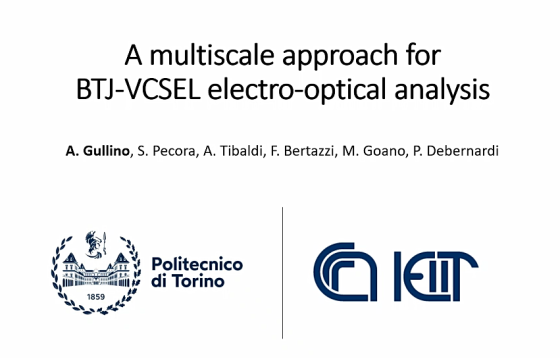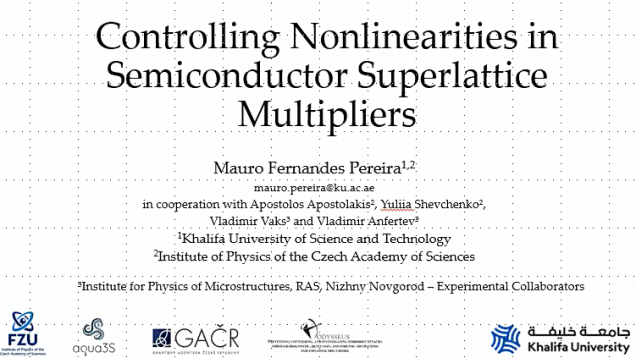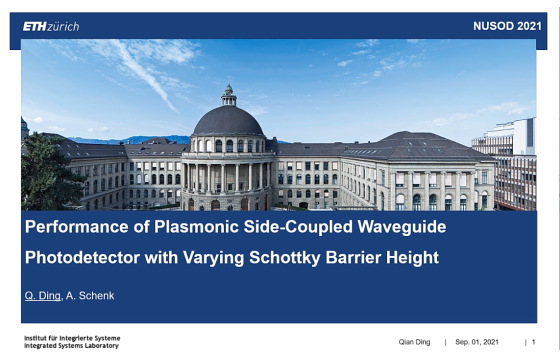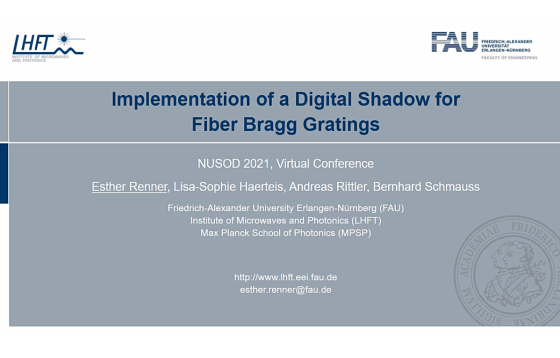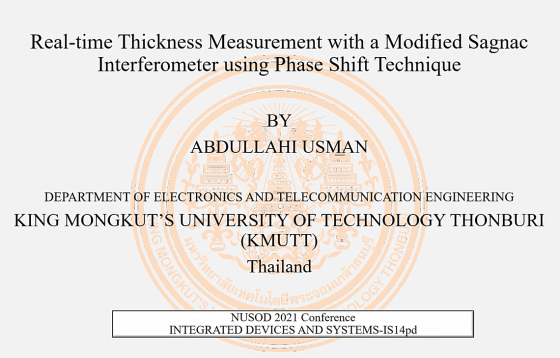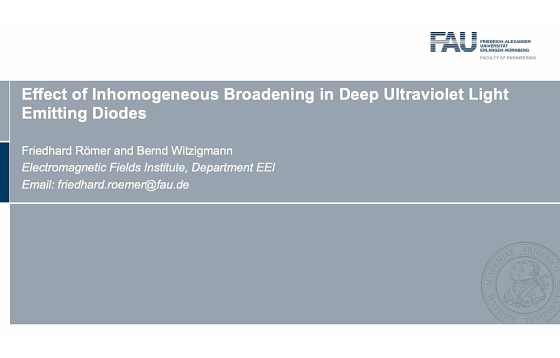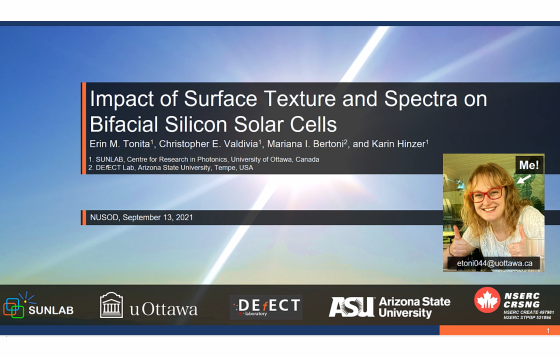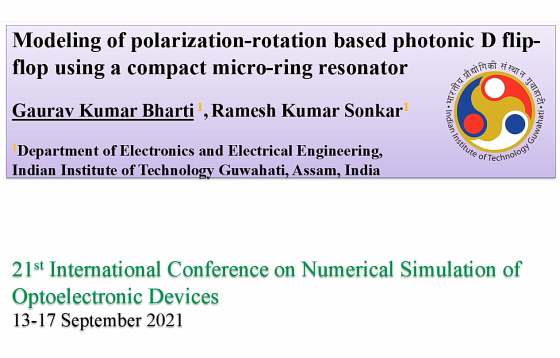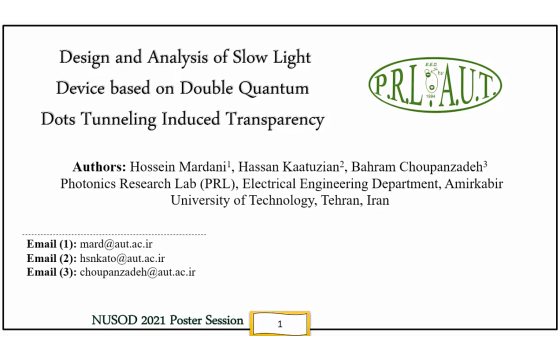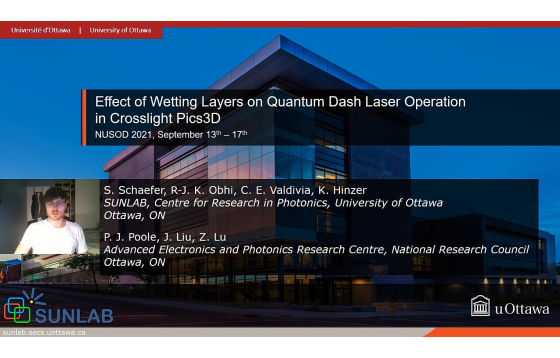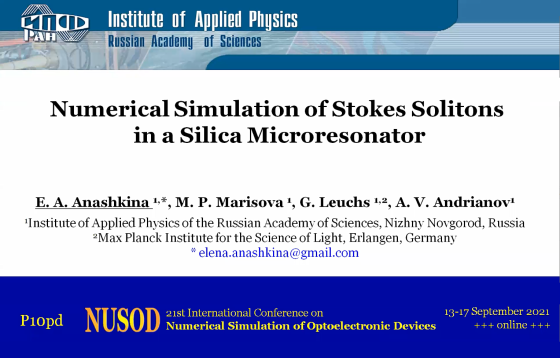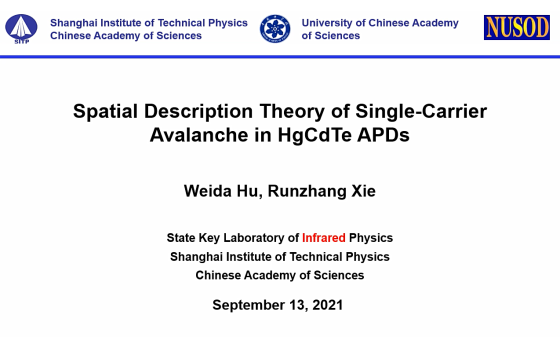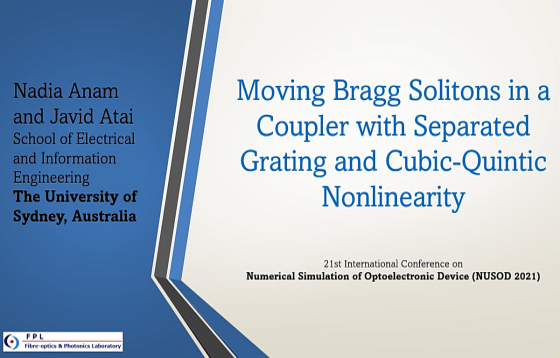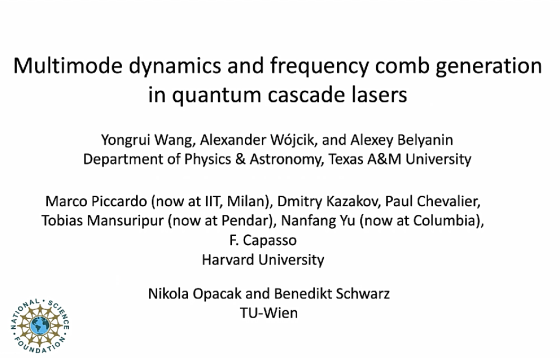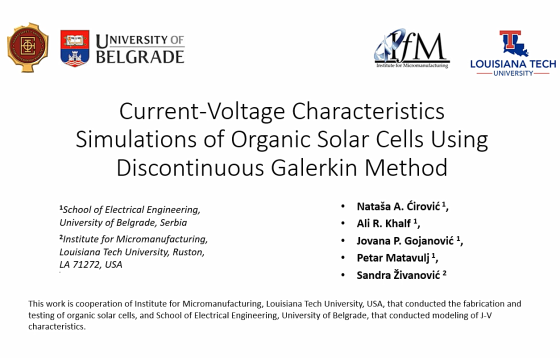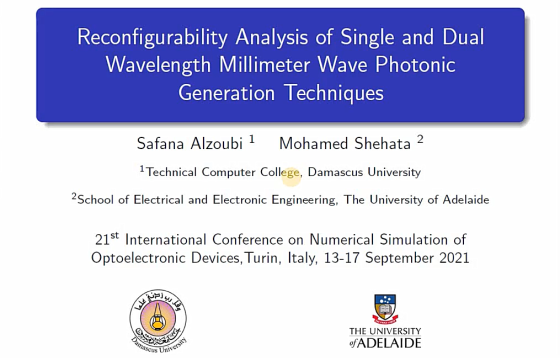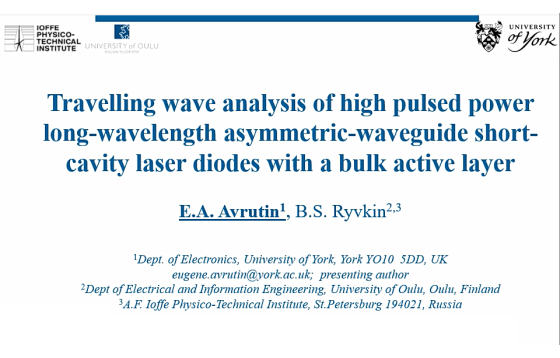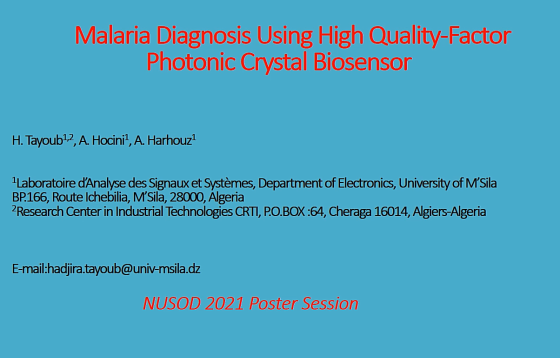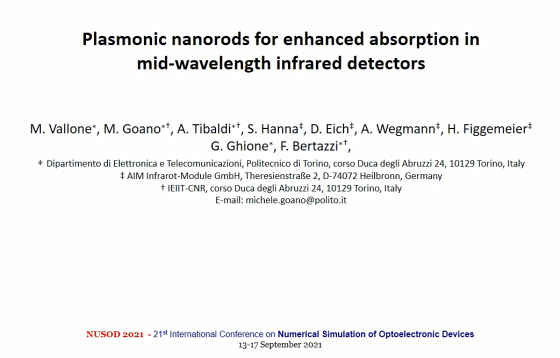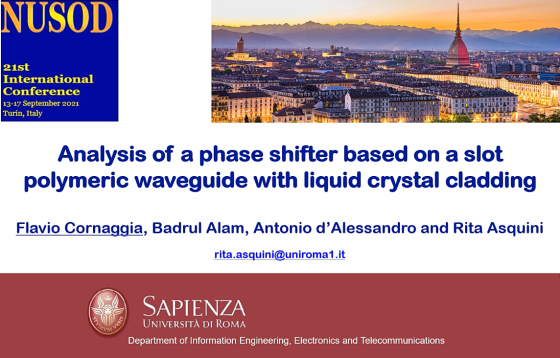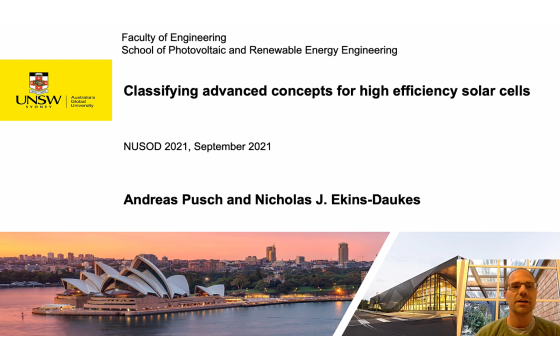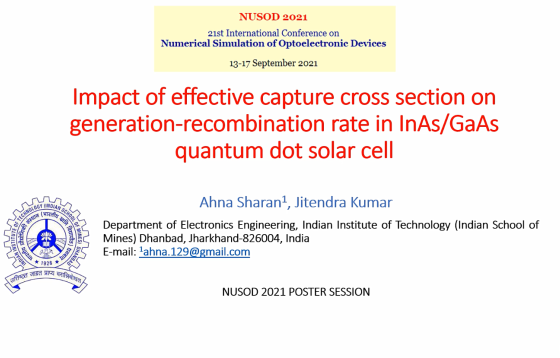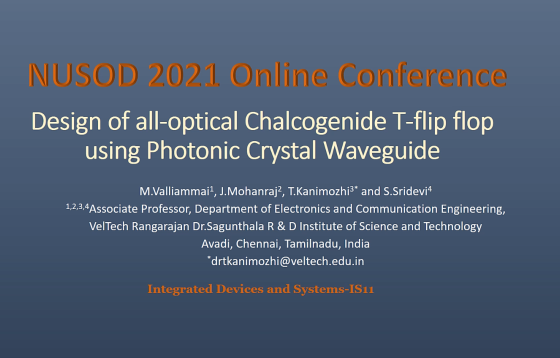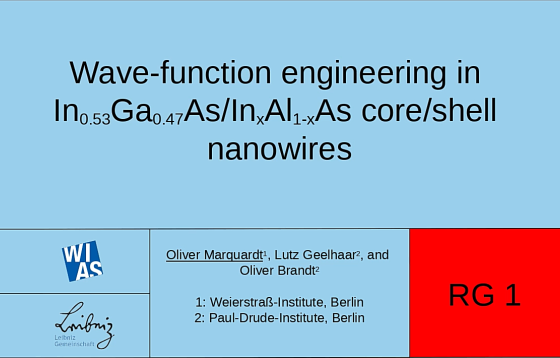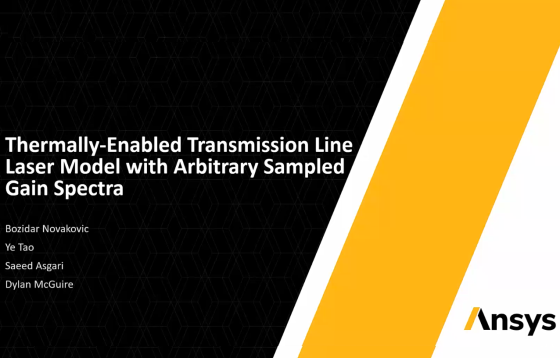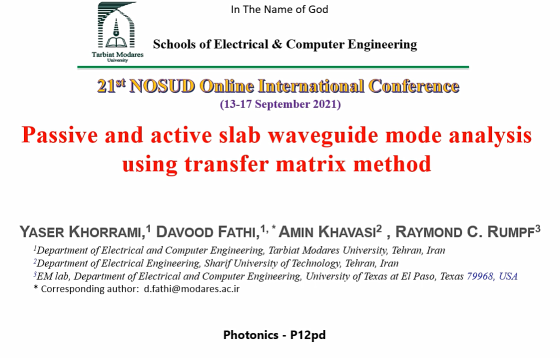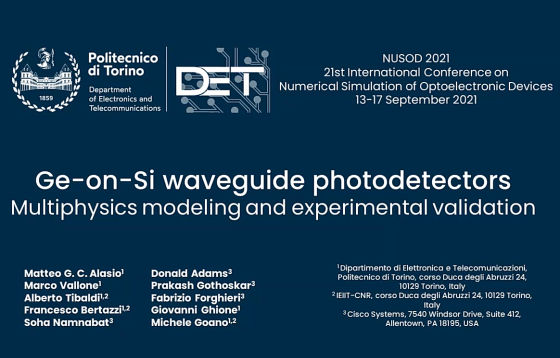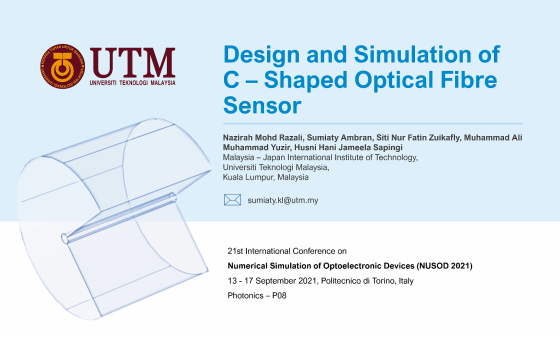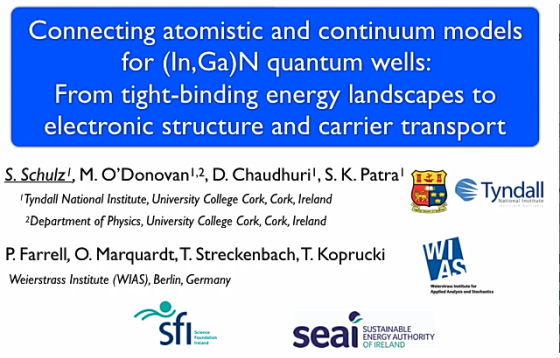


This paper presents a theoretical comparison of the electro-optical characteristics of 850 nm GaAs/AlGaAs pinand BTJ-based VCSELs. The calculations are based on a drift-diffusion model coupled with a NEGF formalism, able to model accurately the tunneling across the TJ. The resulting LIV characteristics demonstrate promising improvements, at both 25 and 80 ◦C, enabled by TJ […]
MM08–Controlling Nonlinearities in Semiconductor Superlattice Multipliers
A hybrid approach combining Nonequilibrium Green’s Fuctions with solutions of the Boltzman equation, delivers voltage and intrinsic asymmetry control of nonlinearities in semiconductor superlattices. Unexpected nonlinear behavior is predicted for high harmonics as a result of voltage control.
D02–Performance of Plasmonic Side-Coupled Waveguide Photodetector with Varying Schottky Barrier Height
The impact of Schottky barrier height (SBH) on the performance of a side-coupled plasmonic waveguide photodetector (WGPD) is theoretically investigated by 3D optoelectrical simulations. A general decrease of the cut-off frequency is observed for all studied barrier heights (0.1 eV to 0.6 eV), most pronounced in the range (0.3 – 0.4) eV. The degradation is […]
P05–Implementation of a Digital Shadow for Fiber Bragg Gratings
We propose a synthesis model for fiber Bragg gratings (FBGs) to monitor temperature measurement errors due to aging behavior. This approach might be called a Digital Shadow since we are able to monitor all essential parameters of the grating to perform error prediction and consequently compensation. The model is tested during accelerated aging experiments, which […]
IS14pd–Real-time Thickness Measurement with a Modified Sagnac Interferometer Using Phase Shift Technique
The modified Sagnac interferometer with a phase-shift approach is given here for measuring Ta2O5 thin-film thickness. The input light is split into reference and sample beams. A real-time signal measurement is performed to get the output intensities of both beams with four different polarizer settings. These intensities can then be effectively converted into film thickness.
LED01–Effect of Inhomogeneous Broadening in Deep Ultraviolet Light Emitting Diodes
Due to their small dimensions deep ultraviolet (DUV) light emitting diodes (LED) are highly attractive light sources for environmental and medical applications. DUV LEDs generate light in active quantum wells (QW) made of Aluminium Gallium Nitride. The QWs are not lattice matched to the substrate and only few monolayers thick making them susceptible to compound […]
SC04–Impact of surface texture on bifacial silicon heterojunction solar cell carrier loss
We investigate the impact of surface texturing on current loss as a function of depth and wavelength in high efficiency bifacial silicon heterojunction solar cells operating at their maximum power output. We couple 3D ray tracing with TMM thin-film boundary conditions for optical simulations and solve Poisson’s drift-diffusion equations to calculate carrier recombination under both […]
IS09–Modeling of polarization-rotation based photonic D flip-flop using a compact micro-ring resonator
This paper demonstrates the modeling and simulation of all-optical polarization rotation based clocked D flip-flop using a single micro-ring resonator. The simulated results show the switching time of 0.5 ps and the on-off ratio of 25.27 dB.
NM07–Design and Analysis of Slow Light Device based on Double Quantum Dots Tunneling Induced Transparency
Slow light Transparency window can be achieved with the help of Electromagnetically Induced Transparency (EIT) method and Tunneling Induced Transparency (TIT) method accompanied by observing tunneling effect between InAs quantum dot structure with energy gap of 0.35 eV and a thin layer of GaAs potential barrier with energy gap of 1.42 eV. By investigating different […]
LD06–Effect of Wetting Layers on Quantum Dash Laser Operation in Crosslight PICS3D
We discuss the integration of quantum dashes (QDashes) into laser simulations using Crosslight Pics3D, outlining the approach for developing a model featuring asymmetrical active regions. The importance of including wetting layers to accurately represent carrier transport is investigated using results obtained for an InAs/InP QDash laser. While leakage current across the active region is unaffected […]
P10pd–Numerical Simulation of Stokes Solitons in a Silica Microresonator
We report a novel generation regime of Stokes solitons numerically found in a silica microresonator in the framework of the generalized Raman-modified Lugiato-Lefever equation. These solitons can be attained for certain parameters in the anomalous dispersion range when the pump is in the normal dispersion range. We also demonstrate the Stokes soliton-like experimental spectrum similar […]
D01–Probability Theory of Single-Carrier Avalanche in HgCdTe APDs as a Stochastic Process
Recent researches have proven that HgCdTe is a good material to acquire both high multiplication and low excess noise factor at the same time in avalanche photodiodes (APDs). As a pseudo-binary narrow bandgap semiconductor material, HgCdTe exhibits high conduction band nonparabolicity as well as strong alloy scattering, especially for hot electrons, which changes the dynamics […]
P06–Moving Bragg Solitons in a Coupler with Separated Grating and Cubic-Quintic Nonlinearity
We investigate the existence and stability of moving solitons a semilinear directional coupler where one core has cubic-quintic nonlinearity and the other core is linear with uniform Bragg grating.
LD01–Multimode Dynamics and Frequency Comb Generation in Quantum Cascade Lasers
In this talk I will discuss how resonant light-matter interaction in the gain medium of quantum cascade lasers gives rise to a rich nonlinear multimode dynamics and a variety of phase-locked multimode regimes, most notably optical frequency combs with separation between the comb lines changing from one to many dozen round-trip frequencies. I will review […]
SC05–Current-Voltage Characteristics Simulations of Organic Solar Cells Using Discontinuous Galerkin Method
The steady state drift-diffusion model (DDM) of organic solar cells that considers the surface recombination processes for majority and minority carriers, as well as their thermionic emission on both electrodes, is presented in this paper. When the full Robin boundary conditions (BCs) and the popular finite difference method with Schaffeter-Gummel discretization (FDSG) were applied, significant […]
IS10–Reconfigurability Analysis of Single and Dual Wavelength Millimeter Wave Photonic Generation Techniques
Optimizing the operating conditions of a Mach-Zhender modulator (MZM) for different design requirements has drawn considerable research interests due to its key role as an electro-optic (EO) interface in hybrid access radio-over-fiber networks. In this work, we compare the modulation efficiency and the bit error rate (BER) performances of single and dual-wavelength-modulated millimeter-wave (MMW) photonic […]
N01–Nanowire antennas embedding single quantum dots: towards the emission of indistinguishable photons
Nanowire antennas embedding a single semiconductor quantum dot (QD) represent an appealing solid-state platform for photonic quantum technologies. We present recent work aiming at generating indistinguishable photons with this system. We first investigate decoherence channels that spectrally broaden the QD emission, and discuss in particular the impact of nanowire thermal vibrations. We also develop nanowire […]
LD07–Travelling wave analysis of high pulsed power long-wavelength asymmetric-waveguide short-cavity laser diodes with a bulk active layer
An effective one-dimensional travelling wave model is used to analyse the performance of a short-cavity asymmetric waveguide high pulsed power laser diodes. The effect of longitudinal inhomogeneity is proven to be modest for practical laser designs.
P13pd–Malaria Diagnosis Using High Quality-Factor Photonic Crystal Biosensor
In 2019, they accounted for 67% (274,000) of all malaria deaths worldwide, according to the World Health Organization; the african region was home to 94% of malaria cases and deaths. In this context, it is vital to detect malaria more effectively and accurately, we have developed in this paper a two dimensional photonic crystal biosensor […]
D03–Plasmonic nanorods for enhanced absorption in mid-wavelength infrared detectors
The absorption properties of HgCdTe based infrared detectors can be greatly increased in the mid-infrared band, by incorporating nanostructured plasmonic arrays on the illuminated detector face. The array periodicity, combined with the excitation of surface plasmon-polariton stationary modes, enhances the absorption efficiency by a substantial amount, allowing to reduce in turn the HgCdTe absorption thickness.
P07–Analysis of a phase shifter based on a slot polymeric waveguide with liquid crystal cladding
We numerically investigated a phase shifter based on a polymeric platform by using two different approaches. The device consists of a polymeric slot waveguide covered with an organic liquid crystal cladding, which is a promising configuration for the implementation of polymeric waveguide systems for computation, communication and sensing. Two different nematic liquid crystals have been […]
SC07–Impact of effective capture cross section on generation-recombination rate in InAs/GaAs quantum dot solar cell
Quantum dot solar cell structures have been theoretically analysed to study the impact of effective capture cross sections on quantum dot generation-recombination processes. The Poisson’s and continuity equation were solved self-consistently to obtain electrostatic potential, electron and hole carrier distribution, and electron filling of the QDs. The occupation probability of the QDs was used to […]
IS11–Design of all-optical Chalcogenide T-flip flop using Photonic Crystal Waveguide
The field of designing photonic crystal based all optical devices is the recent research trend as it remarkably promises an opportunity to diminish circuit complexity. The main intention of this present work is to contrive novel photonic crystal waveguide based all optical chalcogenide T-flip flop. Finally the efficient performance is numerically demonstrated to show elevated […]
N02–Wave-function engineering in (In,Ga)As/(In,Al)As core/shell nanowires
We study the electronic properties of In0.53Ga0.47As/InxAl1–xAs core/shell nanowires for light emission in the telecommunication range. In particular, we systematically investigate the influence of the In content x of the InxAl1–xAs shell and the diameter d of the In0.53Ga0.47As core on strain distribution, transition energies, and the character of the hole wave function. We show […]
LD08–Thermally-Enabled Transmission Line Laser Model with Arbitrary Sampled Gain Spectra
In this paper we demonstrate a directly coupled opto-electro-thermal (OET) transmission line laser model (TLLM) for edge emitting laser simulations and its comparison to physical simulations and measurements. Our results show that the OET TLLM has comparable computational efficiency to the standard opto-electronic (OE) TLLM and can include self-heating effects with good accuracy. As such […]
P12pd–Passive and active slab waveguide mode analysis using transfer matrix method
We present a general approach for numerical mode analysis of the multilayer slab waveguides using the Transfer Matrix Method (TMM) instead of the Finite Difference Frequency Domain (FDFD) method. TMM consists of working through the device one layer at a time and calculating an overall transfer matrix. Using the scattering matrix technique, we develop the […]
D04–Ge-on-Si waveguide photodetectors: multiphysics modeling and experimental validation
This work compares a multiphysics modeling approach with experimental measurements of two Ge-on-Si butt-coupled waveguide photodetectors. The coupled three dimensional electromagnetic and electrical simulation of the frequency response shows promising agreement with the measurements at 1310 nm, and provides detailed information about significant microscopic quantities, such as the spatial distribution of the optical generation rate.
P08–Design and Simulation of C-Shaped Optical Fiber Sensor
This paper presents a C-shaped optical fiber sensor for refractive index measurement. The design and simulation of the C-shaped optical fiber were conducted via Wave Optics Module-COMSOL Multiphysics®. The refractive index measurement ranging from 1.30-1.40 is performed. The simulation results showed that the C-shaped design has the potential to act as a refractive index sensor […]
MM01–Connecting atomistic and continuum models for (In,Ga)N quantum wells: From tight-binding energy landscapes to electronic structure and carrier transport
We present a multi-scale framework for calculating electronic and transport properties of nitride-based devices. Here, an atomistic tight-binding model is connected with continuum based electronic structure and transport models. In a first step, the electronic structure of (In,Ga)N quantum wells is analyzed and compared between atomistic and continuum-based approaches, showing that even though the two […]

